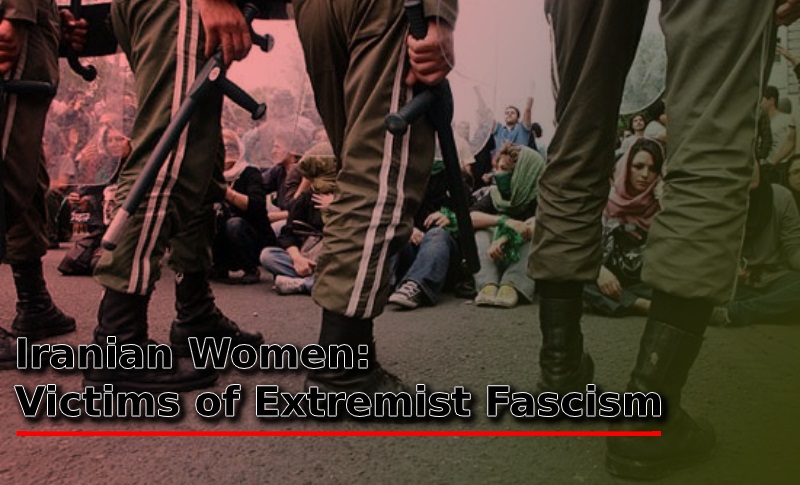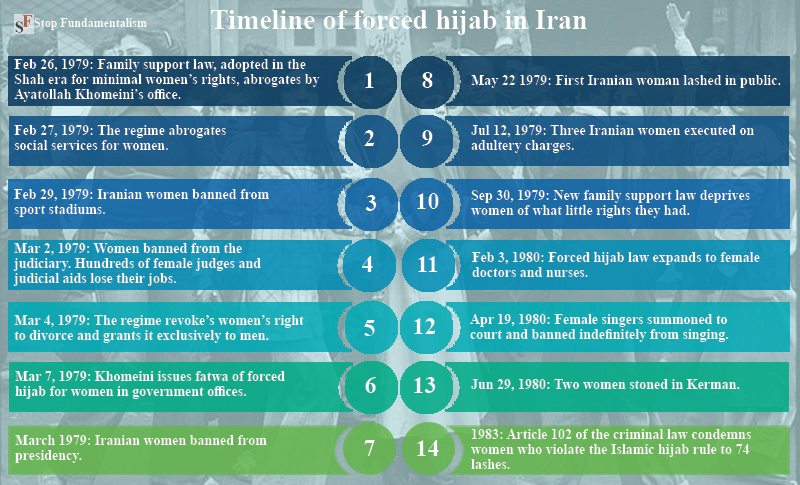
By Armin Baldwin
Iranian women, victims of Islamic fundamentalism
In 1979, Ruhollah Khomeini seized power in Iran and established a brutal theocracy founded on an Ideology that encouraged the discrimination of women under the pretext of Islam.
From the very beginning, Khomeini consolidated his base for repression in Iran, especially against women. The forced hijab was his first move toward tightening the noose around women. Many Muslim women in particular female supporters of the People’s Mojahedin Organization of Iran (PMOI/MEK), protested against Khomeini by organizing a large rally against the misogynistic law Khomeini tried to justify with the slogan “either hijab or suppression.”
Indeed, Khomeini’s return to Iran marked the rise of Islamic Fundamentalism in the Middle East.
The brave women of Iran took part in the resistance against the clerical regime ruling the country. Many were barbarically executed, tortured, raped and massacred in Iran’s prisons, just for having stood up for their beliefs for freedom and democracy. Many more joined the MEK to continue the struggle for freedom and gender equality.
Harassment and discrimination
The crimes of the Islamic fundamentalists ruling Iran against women are numerous. The past 40 years have witnessed systematic misogyny and violence against Iranian women. Women are officially considered as second-class citizens. In spring 1980, women were banned from being judges and many female judges were ousted from the judiciary system.
Iranian women have half the rights of men. In courts, the testimony of two women is equal to that of one man. Under the misogynistic rules of the mullahs, women are not allowed to enter sports stadiums and watch football games.
In a shocking example, Sahar Khodyari, known as the “blue girl,” set herself on fire after she was given a heavy sentence for “illegally” entering a sports stadium. Khodayari died of her wounds in the hospital.
Forced Hijab is a lever of suppression. In just one year, more than 3.6 million women were controlled, detained and interrogated in the streets under the pretext of violating the dress code.

Timeline of forced hijab in Iran
In Iran’s prisons, in addition to being physically and psychologically tortured, female inmates get raped and insulted simply for being women. Many female prisoners were separated from their children, tortured in front of their child and tortured while being pregnant, including many members of the MEK executed in the 1988 massacre.
Discrimination in employment, restricted public activities, marriage rules, and poverty has led to widespread depression and desperation among young women and girls, and a high rate of suicide.
Iran cruel forced marriage laws
Forced marriage laws are another crime of the Iranian regime against women. In 1982, the mullahs reduced the official marriage age of girls from 18 to 9. The registration of married girls at schools and universities was dependent on authorization by their husbands or father.
On Thursday, September 19, 2019, the European Parliament adopted a resolution condemning Iran’s regime for violating women’s rights. The resolution was adopted with 608 votes in favor, seven against and 46 abstentions.
The resolution “condemns in the strongest terms the ongoing repression of women for objecting to compulsory veiling and for exercising their rights to freedom of expression, association, and peaceful assembly; calls on the Iranian Government to respect the freedom of Iranian women to choose their own dress code.” The EP resolution also praised and supported Iranian women human rights defenders who continue to stand up for their cause despite the difficulties and personal repercussions they are facing.
In remarks to the European Parliament session, Mrs. Anna Fotyga, MEP from Poland, commended the women of Iran for their bravery, determination and will, not only for their struggle for women’s rights but for their protests against the regime.
Mrs. Fotyga also noted that “the main Iranian opposition movement, the National Council of Resistance of Iran (NCRI), is led by a woman,” a reference to Mrs. Maryam Rajavi, president-elect of the NCRI.
The struggle for gender equality in Iran is an important part of the struggle for overthrowing the mullahs’ regime. In fact, without regime change in Iran, any Improvement for the situation of Iranian women is an illusion.
The Role of Iranian Women in the Resistance Movement
That is the reason why we have seen a very active role of Iranian women in the Iranian resistance against the regime during the past 40 years. When confronting a regime whose first victims are women, women must inevitably be on the frontline of the struggle against Islamic fundamentalism. Women have had a very important role in the Iranian people’s struggle for freedom. During the nationwide uprisings in 2017 and 2018, women were at the forefront of protests. They have been the organizers and leaders of many demonstrations that shook the world.
Women form the majority of the members of the NCRI. Also, the organized Iranian opposition movement PMOI/MEK is led by a central council that is composed of 1,000 women. They are the voice and the continued path of Iranian women’s struggle for freedom and democracy since 120 years ago.
In this regard, Mrs. Rajavi said, “Iranian women are proud to have struggled against forty years of despicable religious tyranny, since day one until now. They have produced a glorious resistance movement.”
“To my daughters and sisters across Iran, it is time to organize. Turn your pains, suffering, tears, and yearning into a force of struggle and progress. The future will be shaped in your hands and in your units of resistance and resistance councils,” said Mrs. Rajavi in her message on the occasion of March 8, 2019.
Conclusion
There are many signs that this dark chapter in Iran’s history is coming to an end thanks to the little hands of young schoolgirls, the determination of suppressed and oppressed women of Iran, and the will of the arisen women and female leaders.
Undoubtedly, a bright and shining future awaits Iran’s women and people.
The struggle of Iranian women for liberty and gender equality has a voice and a symbol. Mrs. Rajavi’s 10-point plan for the future of Iran represents the hope and the desire of Iranian people for a change.

PLATFORM FOR FUTURE IRAN – MARYAM RAJAVI







